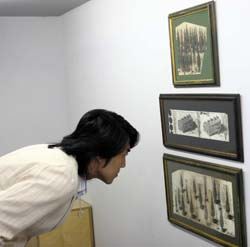Pavlo Makov’s new show called Gardens and Parks
Famous Ukrainian graphic artist launches new exhibition
Pavlo Makov is considered Ukraine’s best graphic artist, and not because he holds this distinction, but because this is what the artistic Boheme was whispering about during the opening of the artist’s new show at the Ya Gallery, called Gardens and Parks of Eastern Ukraine and the Crimea.
This Kharkiv-based artist was born in St. Petersburg. After graduating from the Crimean College of Art in Symferopil, he completed a course of studies at the St. Petersburg Academy of Fine Arts and the Drawing Department of the Kharkiv Industrial Art Institute. He is a member of the Royal Society of Painter-Printmakers (UK), and a corresponding member of the Ukrainian Academy of Arts. Today, Makov is one of the best-known Ukrainian artists in the West. He has had solo exhibitions in Estonia, the Czech Republic, Norway, and Denmark, and his works are owned by the world’s finest museums: the Victoria and Albert Museum in London, the Corcoran Gallery of Art in Washington, D.C., the Metropolitan Museum of Art in New York, the Tretiakov Gallery in Moscow, and the State Museum of Ukrainian Art in Kyiv.
Makov is chiefly known as a master of etching, a technologically difficult and sophisticated technique for which Rembrandt is known. Despite the fact that Makov is considered the creator of elite etchings, he is interested in many other things.
“He is not interested in the trappings of prestige but grassroots culture, everyday culture, the phenomenon of outsiders. Makov studies the urban landscape and the documents of those dreamers who were building Kharkiv,” said art historian Kateryna Zahorska. Proof of these diverse interests is the fact that embedded in his new show is the grid of the telephone communication lines underneath the largest plaza in Europe, Kharkiv’s Liberty Square, which Makov obtained from a group of Kharkiv engineers. That plan formed the basis of the works now on display.
Makov’s new show includes only his latest works from 2007 and 2008. He considers his series of works begun in 2006 (Garden, launched at the Kyiv Museum of Russian Art, and Gardens, unveiled at the Czech Museum of Fine Arts in Prague) to be a new stage of his activities.
Makov worked on his previous big etching project called UtopiA between 1997 and 2004. “My definition of the word ‘utopia’ differs from the classical meaning of this term as a certain impossible future. I understand utopia as something that we really have, as the present. We have nothing more real than utopia.”
Recalling the artist’s previous projects, Zahorska said that “what is new is that this time Makov is heading toward concrete things and concretization. Each depicted object is easily recognizable. It exists in the here and now, and does not depend on the imagination of either the artist or the viewer. Although Makov is not abandoning his favorite theme of gardens, he is stripping them of their formal metaphorical nature, at least for a certain period of time. It is not the object that is changing, it’s the view. Naked reality comes to the foreground.”
Zahorska explained that as paradoxical as this may sound, Makov’s quest for Utopia or exploration is not over. “Now, reality is defined by Makov as one of its possible images. Having reached its limits, reality with all its muck and, at the same time, enjoyment of its own garbage dumps, is transformed into an empty metaphor. Utopia now interests the artist as a reflection of people’s real dreams.
“The essence of people’s dreams constitutes one of Makov’s main focuses. The artist believes that people have not stopped dreaming. But what they dream about has changed. The character, essence, scope, sense, and ways of making dreams true have changed as well.
“In creating his Gardens and Parks series, Makov issues a simple but harsh diagnosis: people’s dreams have gradually become similar to the process of emptying,” the art historian concluded.






